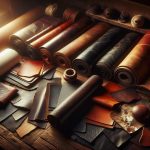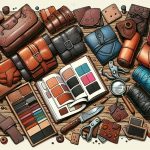Do you ever wonder if leather has a fabric grainline?
In this article, we will explore the concept of grainline in leather and help you understand the relationship between leather and grain.
Discover the importance of grainline in leather products and learn how to identify it in leather materials.
We will also discuss the factors affecting grainline and provide techniques for working with it in leather crafting.
Say goodbye to misconceptions and enhance your design and functionality with proper grainline in leather.
Let’s dive in!
Table of Contents
Exploring the Concept of Grainline in Leather
Do you know if leather has a fabric grainline? The answer is no. Unlike fabric, leather does not have a standard grainline.
The grainline in fabric refers to the direction in which the threads are woven, which affects the way the fabric drapes and stretches. However, in leather, the grain is the natural pattern on the surface of the hide, which is formed by the arrangement of the animal’s hair follicles. This pattern can vary greatly depending on the type of leather and the part of the animal it comes from.
Grainline variations in different types of leather can be quite distinct. For example, full-grain leather, which is made from the top layer of the hide, retains the natural grain and has a more textured appearance. On the other hand, corrected-grain leather, which has undergone a process to remove imperfections, may have a more uniform and smooth grain pattern.
When it comes to incorporating grainline into leather garment construction, designers and manufacturers often prioritize the aesthetic appeal of the leather rather than its grainline. They may choose to cut leather panels in a way that highlights the natural grain pattern or create unique designs that utilize the natural variations in grain. However, unlike fabric, the grainline does not play a significant role in the construction or fit of leather garments.
Understanding the Relationship Between Leather and Grain
To understand the relationship between leather and grain, you should take note of its natural texture and pattern. The grain refers to the outer surface of the leather, which is the most durable and highest quality part. The grain pattern is unique to each animal and can vary from smooth and uniform to textured and irregular. Understanding leather grain patterns is essential in determining leather quality and durability.
Here are three reasons why:
-
Authenticity: Genuine leather has visible grain patterns, which distinguish it from synthetic materials. The presence of natural grain indicates the authenticity and quality of the leather.
-
Strength and Durability: Leather with a tight and consistent grain pattern tends to be stronger and more durable. A well-defined grain indicates that the leather has been properly processed and will retain its strength over time.
-
Aesthetics: Grain patterns give leather its character and unique appearance. Whether it’s a smooth, fine grain or a rugged, textured grain, it adds depth and visual interest to leather products.
The Importance of Grainline in Leather Products
When it comes to leather products, understanding the importance of grainline is crucial.
The grainline determines the quality of the leather, impacting its durability and overall appearance.
Grainline Determines Quality
The grainline of leather determines its quality. When evaluating the quality of leather, the grainline has a significant impact. The grainline refers to the direction in which the fibers of the leather run. This plays a crucial role in determining the strength, durability, and overall appearance of the leather product.
A well-defined and consistent grainline indicates high-quality leather, as it suggests that the fibers are aligned and the material is uniform. On the other hand, an inconsistent or irregular grainline may indicate lower quality leather, as it suggests that the fibers are not properly aligned or the material is of lower grade.
Therefore, when assessing the quality of leather, paying attention to the grainline is essential as it provides valuable insights into the overall integrity and longevity of the product.
Impact on Durability
You can determine the durability of the leather by examining the consistency and alignment of its grainline. The grainline is the pattern formed by the fibers in the leather, and it plays a crucial role in the overall quality and longevity of the material.
Here’s how the grainline impacts the durability of leather:
-
Strength: A well-defined and aligned grainline indicates that the leather is strong and less likely to tear or stretch easily. This enhances the durability of the leather, making it more resistant to wear and tear.
-
Comfort: The grainline also affects the comfort level of leather products. When the grainline is consistent and aligned, it creates a smoother and more supple surface, which enhances the comfort of wearing or sitting on leather items.
-
Aging: Over time, the grainline can change due to natural aging processes. However, if the original grainline is strong and well-defined, the leather will age gracefully, developing a rich patina that adds to its beauty and character.
Affects Leather Appearance
To enhance the appearance of your leather products, ensure that the grainline is consistent and aligned. The grainline refers to the direction in which the fibers of the leather run. When the grainline is consistent, it creates a uniform texture and appearance, making the leather look more polished and professional. On the other hand, if the grainline is not aligned properly, it can result in a distorted or uneven texture, affecting the overall look of the leather. Additionally, the grainline also has an impact on the durability of the leather. When the fibers are aligned correctly, it enhances the strength and resilience of the leather, making it more resistant to wear and tear. Therefore, paying attention to the grainline is crucial for both the appearance and durability of your leather products.
| Consistent Grainline | Inconsistent Grainline |
|---|---|
| Uniform texture | Distorted texture |
| Polished appearance | Uneven appearance |
| Enhanced durability | Reduced durability |
| Resistant to wear | Prone to wear |
How to Identify Grainline in Leather Materials
Identifying the grainline in leather materials is essential for understanding its quality and durability. When it comes to leather crafting, knowing how to identify the grainline can greatly impact the outcome of your project. Here are a few key reasons why understanding the grainline in leather is important:
-
Quality: The grainline in leather refers to the direction in which the fibers run. By identifying the grainline, you can determine the strength and integrity of the leather. Leather with a strong and well-defined grainline is generally of higher quality and will last longer.
-
Durability: Leather that is cut against the grainline is more prone to stretching and tearing. By understanding the grainline, you can ensure that you are using the leather in the most durable way possible, resulting in a longer-lasting finished product.
-
Appearance: The grainline in leather affects its appearance. By working with the grainline, you can create a more visually appealing finished piece. The natural patterns and textures of the leather are best showcased when aligned with the grainline.
Factors Affecting the Grainline in Leather
In understanding the factors that affect the grainline in leather, it’s important to consider the environmental influences on the material. Factors such as temperature, humidity, and exposure to sunlight can impact the alignment and appearance of the grainline.
Additionally, the tanning process itself can also have an effect on the grainline, as different tanning methods can result in varying grain patterns.
Lastly, the texture of the leather itself, whether it’s smooth or textured, can influence the visibility and feel of the grainline.
Environmental Influences on Grainline
The environmental factors affect the grainline of fabric. When exploring the grainline in different natural materials, it is important to understand the impact of these factors on product performance.
Environmental conditions such as humidity, temperature, and exposure to sunlight can all influence the grainline of fabric. For example, high humidity can cause the fabric to stretch or shrink, resulting in a distorted grainline. Similarly, extreme temperatures can affect the fabric’s elasticity and alter its grainline.
Additionally, prolonged exposure to sunlight can cause fading and discoloration, which can also affect the appearance and alignment of the grainline. Therefore, it is crucial to consider these environmental influences when working with natural materials and to take appropriate measures to ensure the desired grainline and product performance.
Tanning Process and Grainline
Now that you understand how environmental factors can affect the grainline of leather, let’s explore the tanning process and its impact on leather quality. Tanning is a crucial step in leather production that transforms raw animal hides into durable and flexible materials. Different tanning techniques can result in varying grainline patterns and overall leather quality.
To help you grasp the concept, here is a table outlining common tanning techniques and their effects on leather quality:
| Tanning Technique | Impact on Leather Quality |
|---|---|
| Vegetable Tanning | Produces a natural, organic grainline with excellent durability. |
| Chrome Tanning | Yields a softer leather with a more uniform grain pattern, but may have lower tensile strength. |
| Oil Tanning | Creates a supple and water-resistant leather, but may result in an uneven grainline. |
| Combination Tanning | Combines different tanning methods to achieve desired qualities, such as softness and durability. |
| Synthetic Tanning | Offers consistent grain patterns and color, but may lack the natural characteristics of other techniques. |
Understanding the tanning process and its impact on leather quality can help you make informed decisions when choosing leather products.
Leather Texture and Grainline
Take a closer look at the different textures and patterns found in leather.
When exploring leather grain patterns, it’s important to understand the difference between natural and synthetic leather.
Natural leather has a unique grain pattern that is a result of the animal’s skin it comes from. It can have variations in texture and pattern, such as smooth, pebbled, or even a distressed look.
On the other hand, synthetic leather is created to mimic the look and feel of real leather but doesn’t have the same natural grain pattern. Instead, it often has a more uniform texture and pattern.
Techniques for Working With Grainline in Leather Crafting
When working with leather, it’s important to consider the grainline and techniques for crafting with it. The grainline refers to the direction of the fibers in the leather, which can affect its strength, flexibility, and appearance. Understanding the grainline is crucial for successful leather crafting.
One of the key techniques for working with the grainline in leather crafting is cutting. When cutting leather, it’s important to follow the grainline to ensure that the finished product is strong and durable. Cutting against the grainline can weaken the leather and cause it to tear easily. By cutting along the grainline, you can maximize the strength and longevity of your leather projects.
Another technique for working with the grainline is stitching. When sewing leather pieces together, it’s important to stitch along the grainline to ensure that the seams are strong and resistant to tearing. Stitching against the grainline can weaken the seams and cause them to come apart easily. By stitching along the grainline, you can create durable and long-lasting leather items.
Common Misconceptions About Grainline in Leather
Remember, it’s important to understand the common misconceptions about grainline in leather crafting. There are several myths that often circulate, but it’s essential to debunk them in order to achieve successful results in your leather projects.
One common misconception is that leather has a fabric grainline, similar to woven textiles. However, this is not true. Leather is a natural material derived from animal hides and does not possess a grainline like fabric does. Instead, leather has a natural grain pattern that is unique to each hide, which gives it its characteristic texture and appearance.
To further clarify, let’s compare the characteristics of fabric grainline and leather grain pattern in the following table:
| Fabric Grainline | Leather Grain Pattern | |
|---|---|---|
| Type | Linear | Varied and Organic |
| Texture | Smooth and Consistent | Textured and Irregular |
| Direction | Follows the weave | Follows the natural hide |
Enhancing Design and Functionality With Proper Grainline in Leather
Now that you understand the common misconceptions about grainline in leather, let’s explore how you can enhance the design and functionality of your leather products by properly incorporating the grainline.
When designing with grainline in leather, it is important to consider the natural characteristics of the material. The grainline refers to the direction of the fibers in the leather, which affects its strength and durability. By aligning the grainline in specific areas of your design, you can enhance the overall structure and appearance of your leather products.
To maintain the integrity of the grainline in leather, here are some tips to keep in mind. Firstly, avoid cutting against the grainline as this can weaken the leather and cause it to stretch or tear. Secondly, when stitching leather pieces together, sew along the grainline to ensure a secure and durable seam. Additionally, be mindful of the placement of hardware or accessories, such as zippers or buckles, as they can disrupt the grainline and affect the overall aesthetics of the design.
Conclusion
In conclusion, understanding the concept of grainline in leather is crucial for leather crafters and designers. By identifying and working with the grainline, they can enhance the design and functionality of leather products.
Contrary to some misconceptions, leather does have a fabric grainline, which can be affected by various factors. By utilizing proper techniques and paying attention to the grainline, leather artisans can create high-quality and visually appealing products.
So, remember to embrace the grainline and unleash the full potential of leather crafting.
- How Durable Is Chiffon? - April 23, 2024
- Which Cloth Is Very Expensive? - April 23, 2024
- How Can You Tell if Chiffon Is Silk? - April 23, 2024






